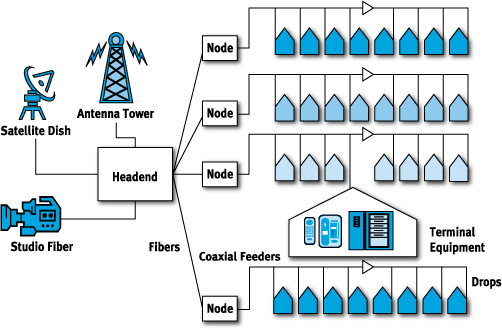Cable television is a system of providing television programs to consumers via radio frequency (RF) signals transmitted to televisions through coaxial cables or digital light pulses through fixed optical fibers located on the subscriber’s property, much like the over-the-air method used in traditional broadcast television (via radio waves) in which a television antenna is required. FM radio programming, high-speed Internet, telephony, and similar non-television services may also be provided. The major difference is the change of radio frequency signals used and optical connections to the subscriber property.
Most television sets are cable-ready and have a cable television tuner capable of receiving cable TV already built-in that is delivered as an analog signal. To obtain premium television most televisions require a set top box called a cable converter that processes digital signals. The majority of basic cable channels can be received without a converter or digital television adapter that the cable companies usually charge for, by connecting the copper wire with the F connector to the Ant In that is located on the back of the television set.
The abbreviation CATV is often used to mean “Cable TV”. It originally stood for Community Antenna Television, from cable television’s origins in 1948: in areas where Over-the-air reception was limited by distance from transmitters or mountainous terrain, large “community antennas” were constructed, and cable was run from them to individual homes. The origins of cable broadcasting are even older as radio programming was distributed by cable in some European cities as far back as 1924.
It is most commonplace in North America, Europe, Australia and East Asia, though it is present in many other countries, mainly in South America and the Middle East. Cable TV has had little success in Africa, as it is not cost-effective to lay cables in sparsely populated areas. So-called “wireless cable” or microwave-based systems are used instead
Broadband Internet is achieved over coaxial cable by using cable modems to convert the network data into a type of digital signal that can be transferred over coaxial cable. One problem with some cable systems is the older amplifiers placed along the cable routes are unidirectional thus in order to allow for uploading of data the customer would need to use an analog telephone modem to provide for the upstream connection. This limited the upstream speed to 31.2k and prevented the always-on convenience broadband internet typically provides. Many large cable systems have upgraded or are upgrading their equipment to allow for bi-directional signals, thus allowing for greater upload speed and always-on convenience, though these upgrades are expensive
